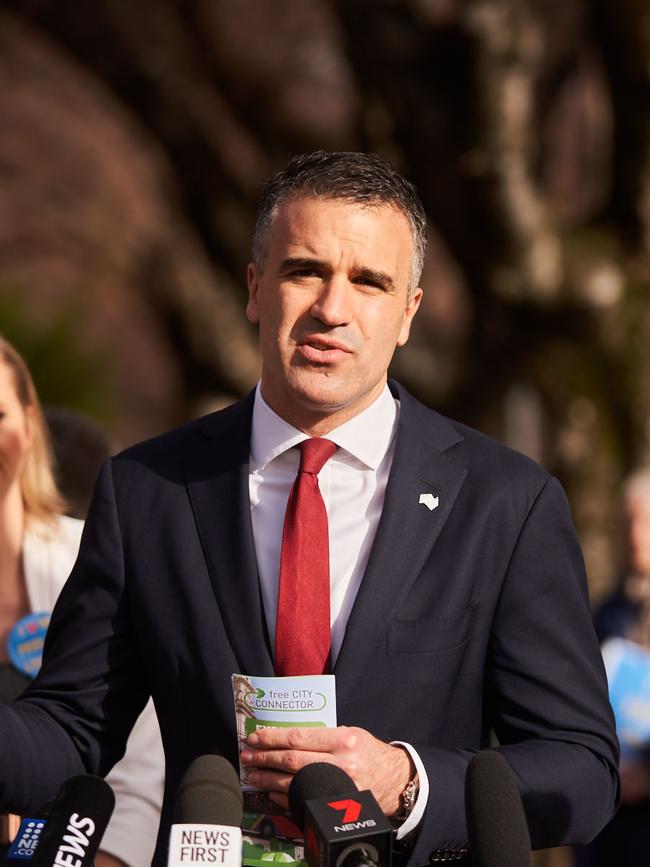Daniel Wills: New electoral battlelines give Labor a fighting chance to take back the castle
New electoral boundaries have given Peter Malinauskas a fighting chance of becoming Premier. But first there’s a major obstacle Labor hasn’t had to face in decades, writes Daniel Wills.
Opinion
Don't miss out on the headlines from Opinion. Followed categories will be added to My News.
- Pyne: Ridiculous electoral shake-up not fair to Liberals
- Are you getting the most from your Advertiser subscription?
Electoral battlelines have shifted dramatically again in South Australia, as the stroke of a pen propels Labor closer to its ambition of reclaiming power after just one term in exile.
SA has a stubborn habit of doing things quite differently when it comes to politics.
Consider the example of former Liberal leader Martin Hamilton-Smith waking up one day and accepting a post in the Labor cabinet, or that odd moment when it seemed former senator Nick Xenophon could up-end the established order and become Premier with an unknown group of independents standing behind him.
Our state elections are unique Galapagos tortoise-like specimens, where getting the most votes doesn’t bring any guarantee of actually winning, and massive changes to the basic makeup of seats has become an idiosyncratic tradition.

For well-intended reasons of history, the Electoral Districts Boundaries Commission is required to review the electoral battlelines between each vote and reshape them to meet a range of often competing and usually impossible ends.
It is the single-most important factor in deciding who will lead us, set by a judge and two public servants who are anonymous to, and remote from, most voters.
The EDBC last week delivered a draft of new boundaries for the 2022 election. It will be tweaked and then finally ratified in November.
In short, on paper, the decision edges Opposition Leader Peter Malinauskas and his Labor team closer to the promised land. But it still requires them to fight hard, and in a way they’ve not had to in a long time.
This will be the first SA election in two decades where Labor are the barbarians at the gate, as the Liberals are fortified inside the castle.
Rather than simply sandbag and keep their ground, Labor must now charge into occupied territory.
After former premier Mike Rann took power from a hopelessly divided Liberal government in 2002, and won a massive landslide four years later, Labor’s electoral strategy was simple: Defend, defend, defend. It used incumbency to full effect.
All the resources of government were marshalled to fund projects for key seats, such as the O-Bahn tunnel and State Aquatic Centre. Labor also had well-known local MPs who’d spent years knocking on doors and attending community events.
Now, Premier Steven Marshall has these advantages as well as a nervous COVID-shaken state which hungers for security.
And the Liberal election machine has finally closed the gap on a Labor operation that humiliated it at four elections in a row. Labor has not taken a state seat from the Liberals since 2006, and successively fallen short in the federal race for Boothby.
If everyone votes again as they did in 2018, Mr Marshall will make history for the long-suffering SA Liberals and be re-elected in a majority.
He will also nurture some hope of reclaiming three notionally Liberal seats now held by independents.
But, critically, the redraw has put three key Liberals seats nearer to Labor’s grasp. A relatively modest swing to Labor of 1.5 per cent, experienced uniformly, would be enough to win. An Advertiser-YouGov poll taken in March, before COVID dug its claws in, showed Labor achieving a significant 4 per cent swing.
MORE NEWS
To underline how crucial the boundaries redraw has become, the 53-47 result Mr Malinauskas achieved in March was at the time not enough – on paper – to give him power under old battlelines. Now, it would be.
The redraw also makes it tougher for the Liberals in a few Labor seats where they may have dreamt of new wins to offset potential losses.
There’s really now just a handful of seats that are clearly in play.
With the disruptive force of Mr Xenophon’s SA Best receding, this shapes as a far more traditional red-on-blue battle in a few streets and suburbs that can expect a lot of love in the next 18 months.
Places such as Modbury, Edwardstown, Nailsworth and Golden Grove will effectively have the power to choose who runs the state in 2022.
Mr Malinauskas’s task is to boost the Labor vote in those places. He has to convince people who voted Liberal last time, and have since got to know some likeable first-term Liberal MPs, that they got it wrong in 2018 and he has the answers they need.
The March poll suggested many are listening, and Labor’s advocacy on public transport is likely to have appealed in some of those working and middle- class communities.
Labor’s next gear must be a more proactive and positive agenda. Mr Malinauskas has already flagged a sharp focus on jobs, education and the environment.
But in a world that seems to be shrinking, the election result could just as easily be swung by promises of building a dog park or bus stop in SA’s newest centres of power.
